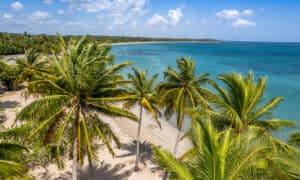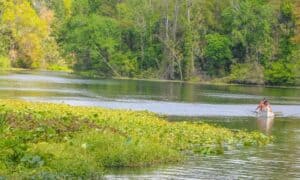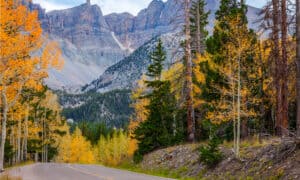Before we delve into discovering the ten largest state parks in Louisiana, let’s explore the history behind the creation of these state parks.
The Chronicles of Louisiana State Parks
In 1934, the government passed legislation to initiate the State Park System in Louisiana, aiming to establish, protect, and maintain recreational centers. They acquired seven sites for this purpose, and four additional sites were purchased, bringing the total State Park land holdings to more than 10,000 acres. However, progress was hindered during World War II, and minimal developments were made. In 1944, only one site was acquired, named “Sam Houston Jones Park.”
In 1952, the legislation expanded the commission’s role to encompass the development of outdoor programs and resources. They renamed the commission to the Louisiana State Parks and Recreation Commission.
In 1966, the National Park Service conducted a review of Louisiana’s state park system, resulting in several suggestions and recommendations that gave rise to specific guidelines and requirements for State Parks.
Following this, in 1970, the management of State Parks underwent restructuring, culminating in the creation of the Office of State Parks and the acquisition of two new parks.
Between 1995 and 2009, Louisiana State Parks invested $80 million in creating new facilities and updating existing ones across the state.
In 2002, Louisiana State Parks welcomed over 2 million visitors.
By 2010, the combined State Parks covered more than 30,000 acres of land, with the addition of Palmetto Island State Park.
10 Largest State Parks in Louisiana
Now that we’ve explored the history behind the creation of State Parks let’s delve into our next topic. Here are the ten largest state parks in Louisiana.
1. Chicot State Park
About
Chicot State Park is a state park in Louisiana that covers an area of 6,400 acres. The name Chicot, which means “stumpy” in French, alludes to the numerous cypress stumps and trees that line the lake’s shores.
Established in 1930, Chicot State Park stands as one of Louisiana’s oldest State Parks, located in Ville Platte, Louisiana, and attracting outdoor enthusiasts. The park offers a range of outdoor recreational facilities, including camping, hiking, fishing, and boating.
Chicot State Park boasts Chicot Lake Dam and houses the Chicot State Park Arboretum. The state park, renowned for its rich wildlife, including alligators, deer, and various bird species, is known for its natural beauty.
The Historical Background of Chico State Park
- The park influenced the process of desegregating Louisiana’s state parks system, which previously enforced racial segregation policies influenced by local customs and cultures, leading to varying practices across different areas of the state.
- The National Register of Historic Places lists the park. An important part of the African-American experience in Louisiana.
Chicot State Park is an important part of Louisiana’s community development block grant program. The State Park receives funding from the National Park Service (NPS).
Chicot Lake Dam
- The Chicot Lake dam is part of the Chicot State Park system. It is located on Bayou Chicot, a tributary of the Red River, in Evangeline Parish, Louisiana, near the town of St. Landry.
- The state of Arkansas constructed the dam. This undertaking resulted in the expansion of the lake’s watershed to its current size of 350 square miles.
- The lake holds the distinction of being North America’s largest oxbow lake and the largest natural lake in Arkansas.
- The dam is about 2 miles from the nearest city, St. Landry. The lake is about 0.75 miles wide and 21-22 miles long from end to end.
Louisiana Department of Wildlife and Fisheries
The Louisiana Department of Wildlife and Fisheries (LDWF) will draw down Chicot Lake in Evangeline Parish. The LDWF’s integrated aquatic vegetation control plan includes this drawdown. The LDWF manages the fish population in Chicot Lake. Louisiana State Parks owns and operates Chicot Lake.
The Louisiana Department of Wildlife and Fisheries applied foliar herbicide on nuisance plants like water hyacinth, giant salvinia, and common salvinia in Chicot Lake in 2015. They used a total of 52 gallons to manage 63 acres of vegetation. From 2014 to 2020, the Louisiana Department of Wildlife and Fisheries (LDWF) applied various other herbicide treatments to address weed and nuisance plants.
Facilities or Services
Lake Chicot State Park offers facilities such as a marina and boat launch areas situated at Lake Chicot Park, Jack R. Rhodes Lake Front Park in downtown Lake Village, and Chicot County Park. You can use these facilities for lake access and various recreational activities.

Cypress trees growing in Chicot Lake, Chicot State Park, Louisiana.
©JayL/Shutterstock.com
2. Lake Fausse Pointe State Park
Lake Fausse Pointe State Park spans 6,000 acres in Iberia Parish and St. Martin Parish, Louisiana, USA. The park lies approximately 18 miles east of St. Martinville, bordering the Atchafalaya Basin. The park is of significant importance to the Atchafalaya Basin ecosystem, which ranks as the largest wetland and swamp in the United States.
Opportunities and Facilities
Lake Fausse Pointe State Park provides a nature lover’s dream getaway, offering opportunities for birding, paddling, and hiking. Visitors can enjoy various recreational activities, including camping, fishing, boating, and picnicking. The park offers 50 campsites, 18 cabins, and four lodges for rent. It features a boat launch and a fishing pier, making fishing a popular activity. The park boasts diverse wildlife, including alligators, turtles, and various bird species. Multiple hiking trails, such as the 6.5-mile Bayou Loop Trail, meanders through wetlands and hardwood forests, are available.
Over 200 species of birds have been recorded in the park, making it a popular destination for birdwatching. The park is home to a diverse array of wildlife, such as alligators, turtles, and various bird species.

A grove of old-growth cypresses resides in Lake Fausse Pointe State Park.
©Joseph Sohm/Shutterstock.com
3. Fontainebleau State Park
Fontainebleau State Park covers 2809 acres of land on Lake Pontchartrain’s north shore, situated between Bayou Castine and Cane Bayou.
In 1938, the Civilian Conservation Corps (CCC) constructed the park, initially naming it “Tchefuncte State Park” before renaming it Fontainebleau State Pointe Park in the early 1940s.
The park is just 4 miles from the City of Mandeville and is accessible via U.S. Highway 190.
In the early 19th century, Bernard de Marigny de Mandeville, founder of Mandeville town, established a sugar mill, now reduced to ruins, indicating the area’s history of sugar plantations.
Fontainebleau State Park spans a natural boundary between forested uplands to the north-northeast and wetland-dominated lowlands to the south-southwest.
Adjacent to Fontainebleau State Pointe Park, Big Branch Marsh National Wildlife Refuge lies to the east and southeast, co-managed by the U.S. Fish and Wildlife Service and the Louisiana Department of Wildlife and Fisheries.
The Lake Pontchartrain shoreline provides a habitat for diverse wildlife, particularly migratory birds and endangered species, supporting over 5,000 wintering waterfowl, including Mallards, gadwall, and Northern Pintails. The refuge’s pine forest hosts the endangered red-cockaded woodpecker and American bald eagle nesting.

A historic sugar mill remains in ruins at Fontainebleau State Park near Mandeville, Louisiana, with the brick chimney and partial brick walls still standing from the 19th-century facility.
©iStock.com/Teresa Otto
4. Poverty Point Reservoir State Park
Located in Richland Parish, Northeastern Louisiana, Poverty Point Reservoir State Park stretches along a 2,700-acre man-made reservoir. Named after an archaeological site dating from 1400 BC to 700 BC, the Reservoir features Native American earthworks and artifacts. Established in 2005, it offers camping, fishing, and water sports. The Reservoir hosts numerous fish species, making it a year-round angler’s paradise. You can find largemouth bass, black crappie, bluegill, and channel catfish, depending on the season.
The park provides two 4-lane boat launches at the North Marina complex and at the South Landing, granting easy water access. Boasting approximately 400 bird species, the park is a haven for birdwatchers. It gains added allure from its surroundings: Lake Pontchartrain, Bayou Caine, and Bayou Castine envelop three sides. At the heart of it all is the 2,700-acre man-made lake, perfect for water sports and offers a stunning backdrop for waterfowl migrations in spring and fall.
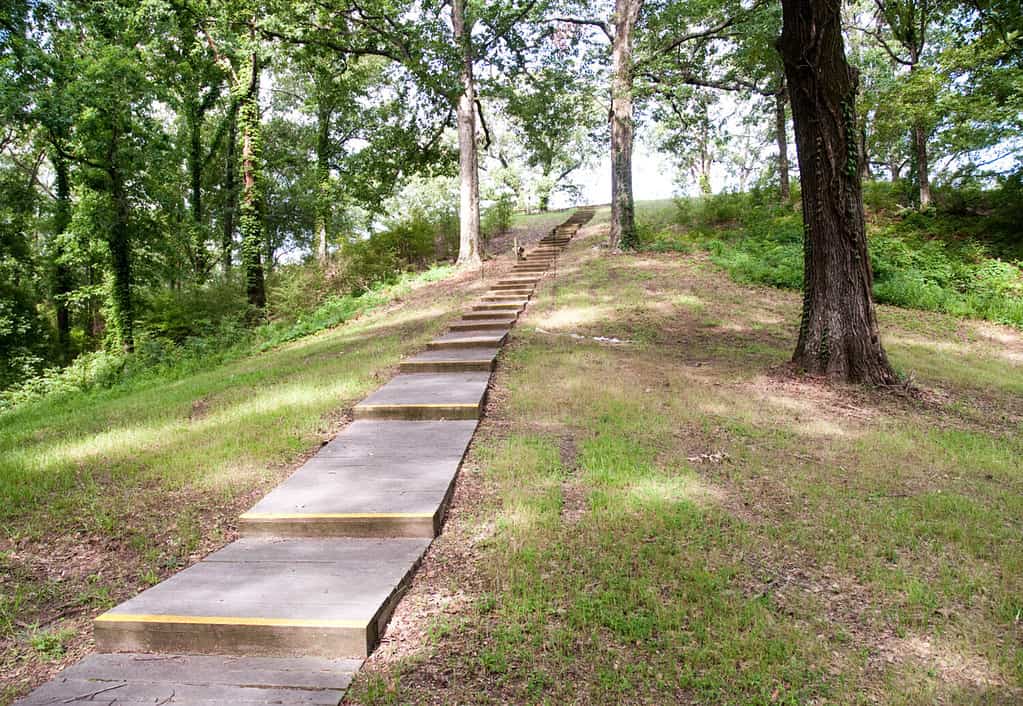
Poverty Point State Historic Site.
©Zack Frank/Shutterstock.com
5. Bogue Chitto State Park
This park is around 1,786 acres in size and opened to the public on August 28, 2010. Bogue Chitto State Park is a recent addition to the Louisiana State Parks. The name, “Bogue Chitto River,” derives from the nearby river, signifying “big stream.” The Choctaw tribe, the original inhabitants of the Bogue Chitto River area, named it due to its size and significance.
Both the Choctaw tribe and early European settlers in the 18th and 19th centuries utilized the Bogue Chitto River for trade and transportation. This river is deeply intertwined with the region’s culture and history, serving as a reminder of the Choctaw people, the area’s original inhabitants.
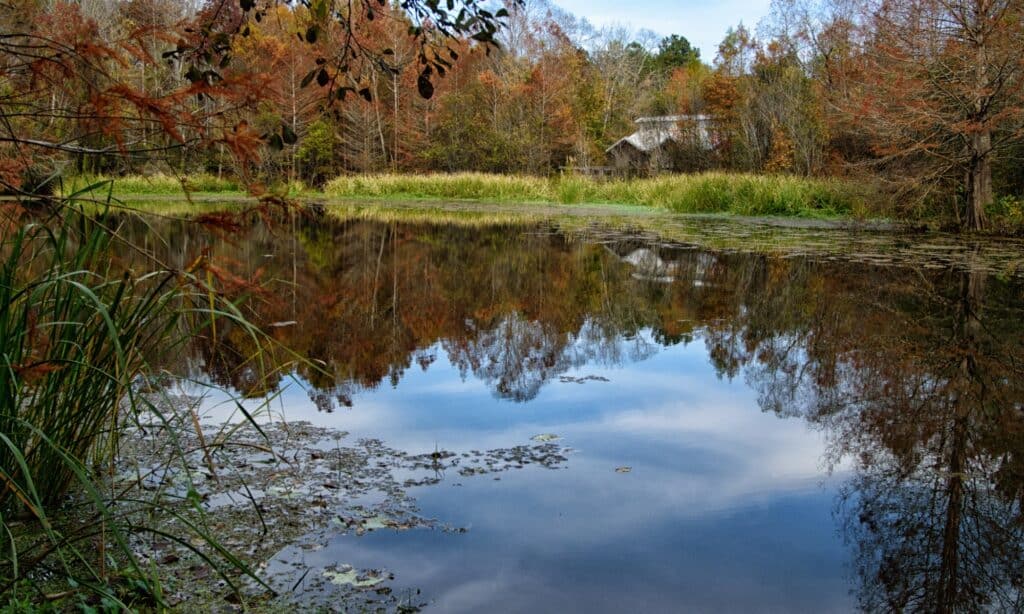
Bogue Chitto State Park, Washington Parish, Louisiana.
©iStock.com/Judy Darby
6. Palmetto Island State Park
Palmetto Island State Park is around 1299 acres. It is situated south of Abbeville, Louisiana, in Vermilion Parish, and it is a recent addition to the Louisiana State Park system. It’s renowned for its plentiful palmettos and offers an authentic South Louisiana outdoor experience. The park boasts a boat launch granting access to the Vermilion River for fishing and boating enthusiasts.
With 95 R.V. campsites, including 20 equipped for tent camping and a visitor center complex featuring a water playground and bathhouse, it caters to various outdoor activities. Additionally, a versatile All-purpose room within the complex is available for rent, suitable for meetings, family gatherings, weddings, and various events. For overnight stays, the park provides six two-bedroom cabins tucked away amid the forest.

Famous for abundant palmettos, Palmetto Island State Park showcases the beauty of this small palm species.
7. TickFaw State Park
Tickfaw State Park is around 1200-acre state park located 7 miles west of Springfield, in Livingston Parish, Louisiana. The park opened in May 1999 and quickly became one of Louisiana’s most popular state parks because of its natural setting, recreation opportunities, and proximity to the state’s two cities: New Orleans and Baton Rouge.
The park hosts a nature center, picnic shelters, a sizable fishing pond, 14 cabins, and 50 campsites. Extensive trails and boardwalks spanning over a mile provide exploration opportunities in four diverse ecosystems. The park earns recognition among the 110 sites on the Louisiana Natural Areas Registry for its remarkable natural features. Various birds, fish, reptiles, and mammals find their habitat in its rich natural environment.
Ecosystems: Cypress-tupelo swamp, bottomland hardwood forest, mixed pine-hardwood forest, and the Tickfaw River.
Habitat: American alligators, nine-banded armadillos, North American beavers, white-tailed deer, foxes, Virginia opossums, rabbits, and raccoons.
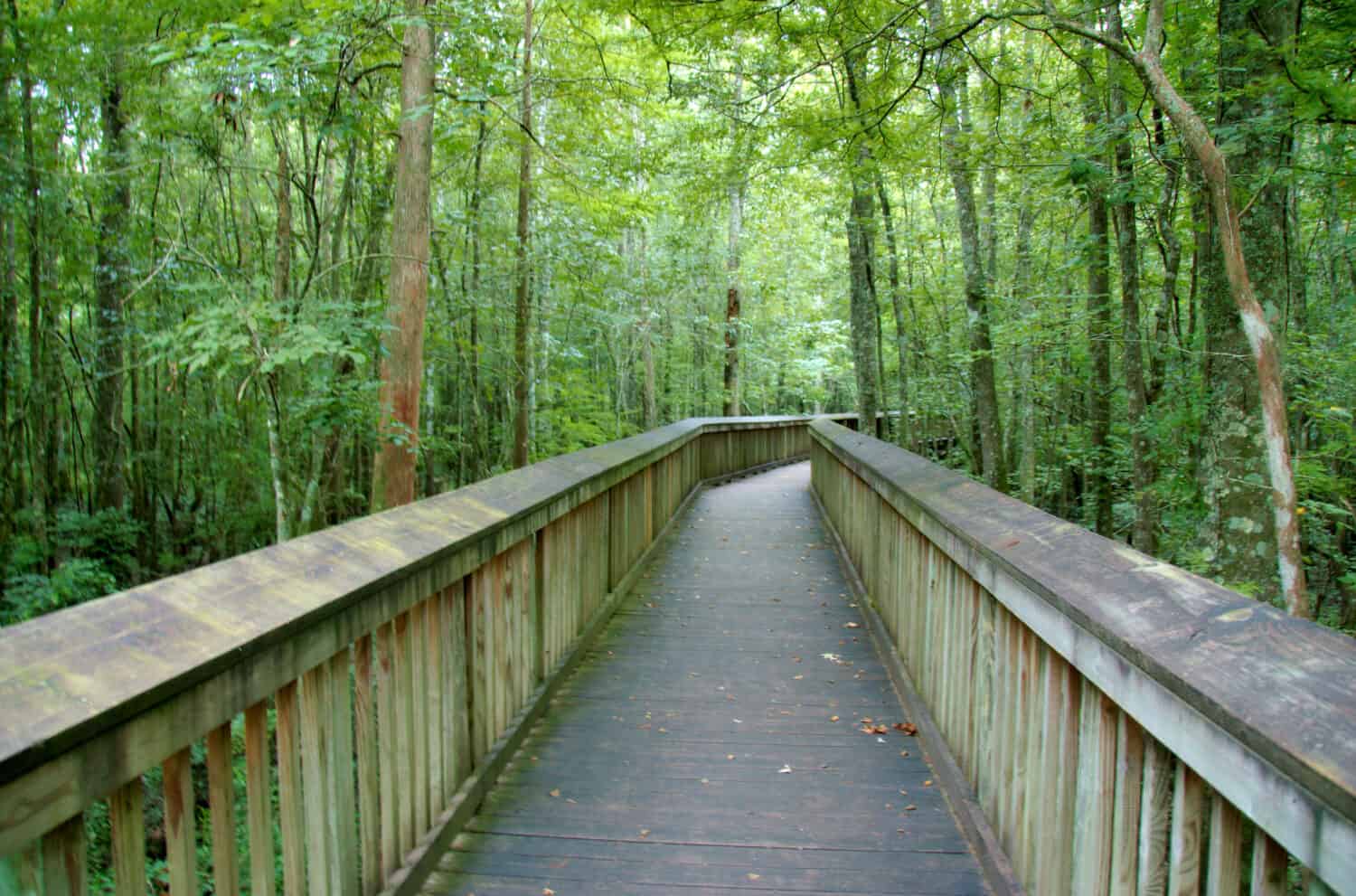
Elevated pathway over a swamp at Tickfaw State Park, situated 7 miles (11 kilometers) west of Springfield in Livingston Parish, Louisiana.
©Roberto Michel/Shutterstock.com
8. Sam Houston Jones State Park
Sam Houston Jones State Park, located in Calcasieu Parish, Louisiana, spans 1,087 acres. Positioned just north of Louisiana’s prime birding region, it attracts birdwatchers. The park provides opportunities for hiking, camping, fishing, and boating. Diverse wildlife, including birds, fish, reptiles, and mammals, inhabit the park. The landscape features a pine and hardwood forest, offering visitors a picturesque natural environment to explore.
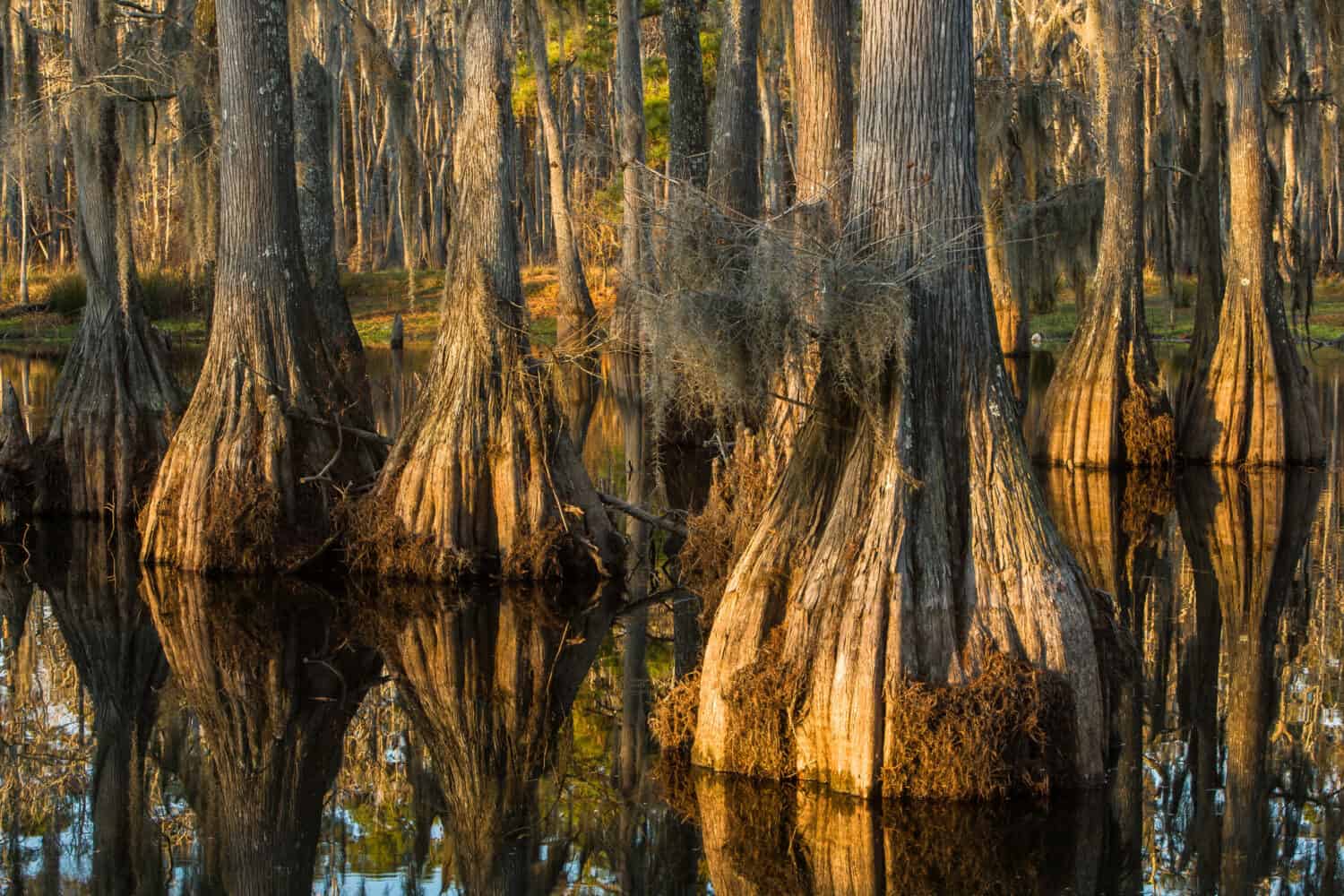
Swamp with bald cypresses at the Sam Houston Jones State Park, Louisiana.
©Laurens Hoddenbagh/Shutterstock.com
9. South Toledo Bend State Park
South Toledo Bend State Park, situated on the shores of Toledo Bend Reservoir at 120 Bald Eagle Road, in Anacoco, Louisiana, spans 1,000 acres. It was acquired in 1979 but only opened to the public with facilities on November 20, 2004.
The park offers picturesque waterfront views from numerous vantage points. Visitors can engage in outdoor recreational activities like hiking, cycling, birding, camping, and wildlife observation. A 3,000-foot surfaced nature trail near the Visitor Center and R.V. camping areas allows exploration. Additionally, the park provides several picnic tables for visitors to enjoy meals or snacks while experiencing South Toledo Bend State Park.
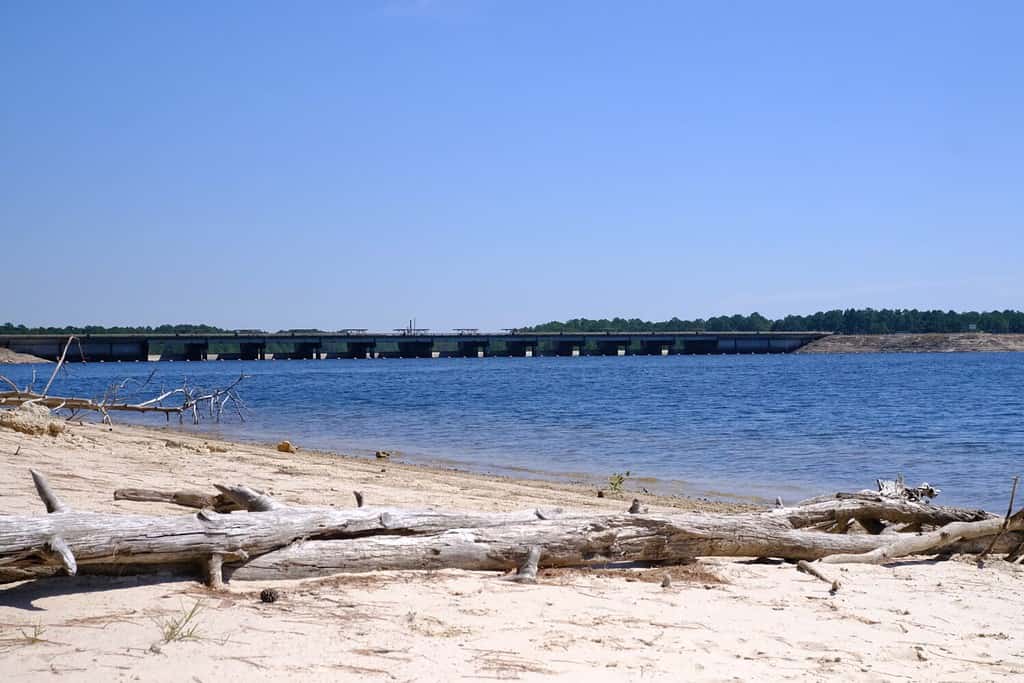
View of the Toledo Bend Forest from South Toledo Bend State Park, Louisiana.
©William Dillingham/Shutterstock.com
10. North Toledo Bend State Park
North Toledo Bend State Park, a 900-acre state park on Toledo Bend Reservoir, is located west of Zwolle, Louisiana, and offers fishing, swimming, boating, and relaxation. A boat launch with a double ramp, a large parking lot, boat rentals, and a fish cleaning station provides access to Toledo Bend Reservoir. Recognized for its outstanding natural characteristics, the park is a popular birdwatching destination.

This photo showcases the Dogwood Nature Trail in North Toledo Bend State Park, situated in Zwolle, Louisiana.
©William Dillingham/Shutterstock.com
Wrap-up
In conclusion, Louisiana’s incredible state parks offer a wide range of recreational opportunities, from fishing and boating to hiking and picnicking. Whether you’re planning a family gathering or simply enjoying the outdoors, don’t forget to bring along some delicious Louisiana dishes like po-boys, jambalaya, gumbo, or the famous Muffuletta sandwiches. Relish these flavors amidst the breathtaking natural surroundings. And remember to responsibly dispose of your trash in designated bins to maintain the cleanliness and greenery of our State Parks.
Top 10 State Parks in Louisiana, Ranked by Acreage From Largest to Smallest
| RANK | NAME | ACREAGE |
| 1 | Chicot State Park | 6400 acres |
| 2 | Lake Faust Pointe State Park | 6000 acres |
| 3 | Fontainebleau State Park | 2800 acres |
| 4 | Poverty Point Reservoir State Park | 2700 acres |
| 5 | Bogue Chitto State Park | 1786 acres |
| 6 | Palmetto Island State Park | 1299 acres |
| 7 | Ticfaw State Park | 1200 acres |
| 8 | Sam Houston Jones State Park | 1087 acres |
| 9 | South Toledo Bend State Park | 1000 acres |
| 10 | North Toledo Bend State Park | 900 acres |
Thank you for reading! Have some feedback for us? Contact the AZ Animals editorial team.




